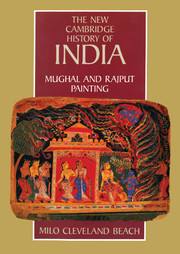Book contents
- Frontmatter
- Introduction
- 1 Painting in North India before 1540
- 2 1540–1580: Painting at Muslim courts
- 3 1580–1600: The new imperial style and its impact
- 4 1600–1660: Mughal painting and the rise of local workshops
- 5 1660–1700: The growth of local styles
- 6 1700–1800: The Dominance of Rajput Painting
- 7 1800–1858: Traditionalism and new influences
- Appendix
- Bibliographical essay
- Index
- The New Cambridge History of India
- References
6 - 1700–1800: The Dominance of Rajput Painting
Published online by Cambridge University Press: 28 March 2008
- Frontmatter
- Introduction
- 1 Painting in North India before 1540
- 2 1540–1580: Painting at Muslim courts
- 3 1580–1600: The new imperial style and its impact
- 4 1600–1660: Mughal painting and the rise of local workshops
- 5 1660–1700: The growth of local styles
- 6 1700–1800: The Dominance of Rajput Painting
- 7 1800–1858: Traditionalism and new influences
- Appendix
- Bibliographical essay
- Index
- The New Cambridge History of India
- References
Summary
By 1700, Rajput palaces contained gardens, courtyards, pavilions, and darbar halls in the Mughal fashion; court dress and manners often followed Mughal standards; and, in the arts, many painters used finer pigments to paint subtler perceptions of the natural world in softer colors and more experimental styles. Neither architects nor painters working for Rajput patrons adopted anything more than this superficial appearance of Mughal taste, however. Even when painting portraits – a Mughal-inspired subject – the Rajput artist showed no sustained interest in the visual specificity, or individual psychological comprehension, that was so distinctive a Mughal contribution to Indian art. Figures remained types. The regard for human portraiture so remarkable in the works of such Mughal artists as Govardhan or Hashim is found virtually nowhere in Rajput painting; compare, for example, figs. 117 and 124. This is, of course, a matter determined by the context of patronage. Some of the greatest Mughal painters were Hindus by personal faith, but the demands of the patron took precedence over the artist’s individual cultural affiliation. In fact, throughout the history of Indian painting, artists took jobs where they were available, and whether or not they were for patrons with whom they shared religious beliefs.
This difference of attitude is nowhere more obvious than in the treatment of space. A sense of spatial depth – whether or not successful by European terms – is basic to the mature phase of Mughal painting (for example fig. 111). By creating a visual equivalent for empty space, in which solid forms are carefully located, the boundaries and thus the inherent separateness of these forms is affirmed.
- Type
- Chapter
- Information
- Mughal and Rajput Painting , pp. 174 - 213Publisher: Cambridge University PressPrint publication year: 1992



